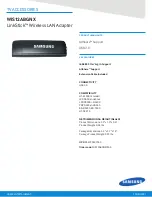
Fabric OS 5.2.x administrator guide 393
Following is the syntax for
portCmd ipPerf
to display end-to-end IP path performance statistics:
portCmd --ipPerf [slot]/ge# -s <source_ip> -d <destination_ip> -S | -R [-r <rate>]
[-z <size>] [-t <time>] [-i <interval>] [-p <port>]
where:
-s
<source_ip>
Source IP address.
-d
<destination_ip>
Destination IP address.
-S
Operates the WAN tool FCIP port-embedded client in the sender mode. The test
endpoint will generate a traffic stream and report the end-to-end IP path
characteristics from this endpoint toward the receiver endpoint. This option cannot be
used with the –R option.
-
R
Operates the WAN tool FCIP-port embedded client in the receiver mode. The test
endpoint will accept a connection and traffic stream from the sender This option
cannot be used with the -S option.
-r
<
rate
>
Committed rate for the data stream in Kb/s. If specified, the traffic generator will be
limited by a traffic shaper. This can be used to characterize the end-to-end IP path
performance based on the data rate to be configured for a tunnel between the same
endpoints. If a rate is not specified then the traffic generator will compete for
uncommitted bandwidth.
-z <size>
Size in bytes for each buffer handed to the TCP layer. If a size is not specified the
maximum size data buffer will be used based on the outgoing IP interface MTU. The
size is the only buffer size that will be handed over to the TCP layer.
-t <time>
Total time in seconds to run the test traffic stream. If a time is not specified, the test will
run continuously until the command is explicitly aborted (ctrl-C). The maximum
allowed size is 1MSS. If you plan to use PMTU discovery, use the default size,
otherwise the PMTU information might not be accurate.
-i <interval>
Interval in seconds between polling and printing stats. The default is 30 sec. If this
time is greater than the running time (specified by –t), the stats will be printed only
once at the conclusion of the test.
-p <port>
TCP port number for the listener endpoint. If a TCP port is not specified, port 3227 is
used (this is next port after ports 3225 and 3226, which are used for the FCIP tunnel
connections).
FCIP Tunnel performance characteristics
You can use the
portShow fcipTunnel
command to view the performance statistics and monitor the
behavior of an online FCIP tunnel. This additional information is reported in the details of the command
output.
The following example shows the use of the CLI
portCmd fcipTunnel
to report the bandwidth, loss,
round trip, and path statistics for each of the TCP connections associated with active FCIP tunnel(s):
switch:admin06> portshow fciptunnel 8/ge0
Summary of Contents for AE370A - Brocade 4Gb SAN Switch 4/12
Page 18: ...18 ...
Page 82: ...82 Managing user accounts ...
Page 102: ...102 Configuring standard security features ...
Page 126: ...126 Maintaining configurations ...
Page 198: ...198 Routing traffic ...
Page 238: ...238 Using the FC FC routing service ...
Page 260: ...260 Administering FICON fabrics ...
Page 280: ...280 Working with diagnostic features ...
Page 332: ...332 Administering Extended Fabrics ...
Page 414: ...398 Configuring the PID format ...
Page 420: ...404 Configuring interoperability mode ...
Page 426: ...410 Understanding legacy password behaviour ...
Page 442: ...426 ...
Page 444: ......
Page 447: ......
















































